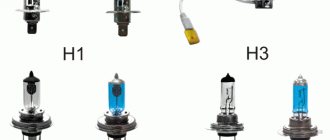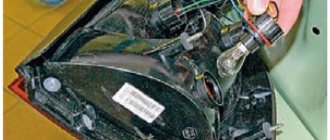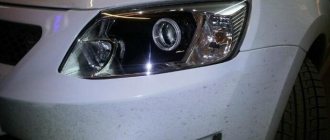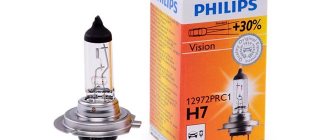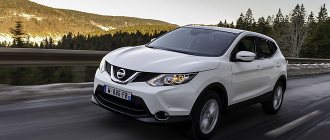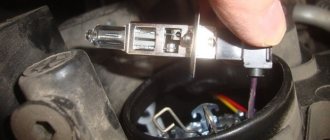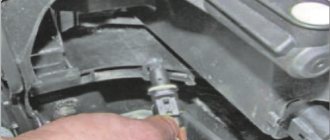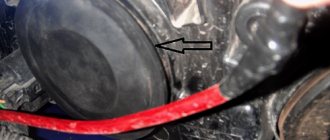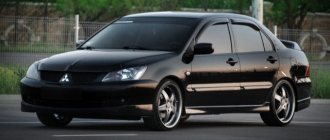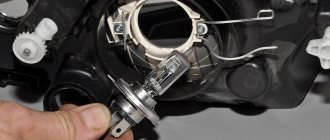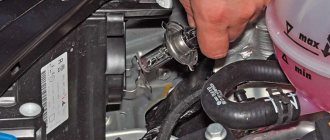The Calina and Kalina 2 models have different headlight designs, so replacing the lamps in them has certain differences, and we will describe which ones in this article. Replacing light bulbs yourself will not cause you any problems. Therefore, there is no point in turning to the service for help.
On Kalina 2 from 2013, to replace the lamps in the left headlight unit, you need to move the air filter to the side so that it does not interfere. There will be nothing in the right headlight block that will prevent replacement.
Review of block headlights Lada Kalina 2
Above is a photo of the left headlight, everything on the right is identical. 1 - ventilation tube; 2 — low beam section cover; 3 — cover of the high beam section; 4 — light beam regulator in the vertical plane; 5 — lamp socket for side light and daytime running light; 6 - electrical connector; 7 — regulator of the light beam in the horizontal plane; 8 - turn signal lamp socket
Instructions for replacing lamps on Kalina 2 Cross
Low beam
Carefully remove the rubber boot from the low beam (it is larger in size)
Disconnect the socket from the light bulb
Next, press the spring clamp and remove it from the clamps to the side and move it away
We remove the burnt out one and install a new lamp. The H7 Osram lamp is installed from the factory; if you want to put a brighter light, you can choose a Philips H7 +30.
We reassemble in reverse order.
High beam
Remove the rubber boot from the high beam
Disconnect the block from the lamp. There is only a + wire on the lamp.
Press the spring clamp of the lamp and move it to the side
We take out the old lamp and replace it with a new one. Be careful when installing, it can only be installed in one position.
We also perform assembly in reverse order.
How to change a DRL lamp
Take the cartridge and turn it counterclockwise.
Next, remove the socket from the socket, remove the old lamp and install a new one. Toshiba lamps are installed from the factory; it is impossible to buy them in retail stores, so we choose an analogue.
Turn signal lamp
By pressing lightly, turn the cartridge counterclockwise and remove it from the socket
Press the lamp and turn it counterclockwise, pull it out of the socket
We take a new PY21W lamp and install it in the socket.
This completes the lamp replacement.
When replacing low and high beam lamps, touching their bulbs is prohibited! This will lead to rapid failure of the lamp. The rest of the lamps are incandescent, and this does not threaten them.
Watch a video on changing light bulbs.
For 15 years I have been repairing various types of cars, including brands such as VAZ, UAZ, Chevrolet, Mazda, Kia and many others. Everything related to the gearbox, engine or chassis. You can write me your question below in the comments and I will try to answer it in detail.
On the territory of the Russian Federation, amendments to the rules of the road (TRAF) have been in force for more than 8 years, according to which a moving vehicle during daylight hours must be indicated by low beam headlights, fog lights (FTL) or daytime running lights (DRL). Using headlights and fog lights for these purposes has a number of disadvantages. Therefore, drivers prefer to buy ready-made running light modules and install them in their cars themselves. How to properly connect daytime running lights so that their operation is safe and does not contradict current laws?
Heading optics contains 4 lamps
Let's look at how the directional optics, that is, the front headlight, is designed. The block contains four compartments, each of which contains one element:
- High beam lamp (H1);
- Low beam lamp (H7);
- Combined lamp for running lights and “dimensions” (W21/5W);
- Turn signal lamp (P21W yellow - PY21W).
The standard size of the element is indicated in parentheses.
If we talk about low and high beams, standard power lamps (55 watts) are installed from the factory. It is not recommended to greatly exceed this value. Lighting fixtures of sizes H1-H7 look like this:
H1 – high beam, H7 – low beam
When making a purchase, the main thing is not to confuse an H7 lamp with a halogen lamp of a similar size (H4). Also, some companies produce 24-volt lighting devices.
When replacing halogen light sources, adhere to the following rules: do not touch the glass with hands without gloves; it is recommended to degrease the lampshade before installation. “Secunda” is suitable as a cleaner.
The following text shows the side and running lights:
Its standard size is W21/5W. Well, the turn signal bulbs in the directional optics use standard ones. They are equipped with a metal base, their standard size is P21W (PY21W).
The yellow lampshade looks like orange
The nuances of turning on running lights
The basic requirements regarding installation, technical parameters and connection of navigation lights are listed in paragraph 6.19 of GOST R 41.48-2004. In particular, the electrical functional circuit of the DRL must be assembled in such a way that the running lights turn on automatically when the ignition key is turned (the engine starts). In this case, they should automatically turn off if the headlights are turned on.
Clause 5.12 of this standard states that headlights (FGS) should be turned on only after the lights are turned on, with the exception of short-term warning signals. When connecting DRLs yourself, this feature must be taken into account.
Correct connection of DRLs is not limited to a well-thought-out functional diagram. It's time to think about the stabilization unit for LEDs. In the running lights themselves, resistors act as a current limiter; however, due to voltage drops, resistors cannot limit the current to the same level. That is why a voltage stabilizer in the running lights connection circuit is extremely necessary. Otherwise, the service life of LED DRL modules is significantly reduced due to constant changes in on-board voltage. Some car enthusiasts claim that it is possible to connect running lights without a stabilizer.
Connecting and installing an LED driver is a waste of time, because the DRLs on LEDs shine regularly for months without any stabilization...
However, this statement is easy to dispute. The fact is that with each voltage surge, more than 12 V appears on the LED module, the forward current through the LEDs exceeds the nominal value, which leads to overheating of the emitting crystal. The brightness of the LEDs decreases, such DRLs will no longer be able to fulfill their immediate task - to warn oncoming drivers from afar, and over time they will begin to flicker and fail.
Using LED DRLs without a voltage stabilizer means spending at least several hundred rubles every year on new modules and wasting time replacing them.
For ease of understanding, the circuits below are shown without using a stabilizer.
Switching on through dimensions or low beam
The second version of the DRL connection diagram involves using the power circuit of the side light bulb. To do this, the positive wire from the running lights is directly connected to the “+” from the battery. In turn, the negative wire is connected to the “+” of the side light, which is currently electrically neutral. As a result, the following current flow path is formed: from the “+” of the battery through the LEDs to the size, and then through the light bulb to the body, which serves as the minus of the entire circuit. Due to the low current consumption (tens of mA), the LEDs begin to glow, and the lamp spiral remains extinguished. If the driver turns on the side lights, then +12 V appears on the positive side of the side lights, the potentials on the DRL wires are equalized and the LEDs go out. The circuit goes into normal mode, that is, current flows through the side light bulbs.
This circuit solution has several disadvantages:
- running lights remain on when the engine is turned off, which is contrary to current regulations;
- the circuit will not work if LEDs are also installed in the dimensions;
- the circuit will not work correctly if the DRLs contain powerful SMD LEDs, the rated current of which is comparable to the current of a light bulb;
- For safety reasons, an additional fuse must be installed.
This connection method can be improved by connecting the positive wire of the LED module not to the “+” of the battery, but to the “+” of the ignition switch, thereby eliminating the first drawback. Some motorists use schemes for turning on running lights through a low beam lamp. That is, when the low beam is turned on, the DRLs automatically go out, but in other cases they work. In addition to the above disadvantages, this method does not comply with GOST R 41.48-2004 and traffic rules.
When parking a car at night, side lights are used to indicate it; the use of DRLs is prohibited.
Other lamps in the station wagon and hatchback
To illuminate additional equipment in Kalina-2, lamps of standard size C5W are used. They are:
- In the license plate light socket ;
- In the trunk light;
- In the glove compartment lighting module.
The interior is illuminated by a C10W lamp, and additional side lamps are equipped with T4W lamps.
Light bulbs and body turn signals
The side turn signals are equipped with incandescent lamps without a socket (W5W). And H11 lamps can be installed in the front fog lights. Successful replacement.
Connection via a 4-pin relay from a generator or oil sensor
The following two methods have a common basis and imply the operation of daytime running lights only after the engine is started. The circuit for switching on DRL from the generator is based on switching a four-contact relay and a reed switch. The DRL relay contacts are connected as follows:
- 30 – to the positive terminals of LED modules;
- 85 – to the positive wire to the dimensions;
- 86 – to any reed switch output;
- 87 and the second terminal of the reed switch - to the “+” of the battery.
After checking the reliability of all contacts, proceed to setup. To do this, start the engine and, by moving the reed switch near the generator, achieve its activation and a stable glow of the DRL. Then the reed switch is hidden in a thermal tube and fixed in the found place using nylon ties.
At the moment of starting the engine, and then the generator, the contacts of the reed switch and relay close, supplying power to the LED running lights. In this case, the side lamps remain turned off, since the current through the relay coil is small to light them.
In the absence of a reed switch, you can power the DRL from the oil pressure sensor. In this case, pin 86 is connected to the oil pressure lamp. The rest of the circuitry is duplicated. Both schemes have a common drawback. They cannot be used if LEDs are installed in the dimensions.
Connection via 5-pin relay
Now it's time to learn how to connect running lights via a five-pin relay. The scheme is the most universal, and was assembled to eliminate the disadvantages of previous options. First, about connecting the relay for DRLs:
- 30 – to the positive terminals of LED modules;
- 85 – to the positive wire of the side lamp;
- 86 – on the car body;
- 87a – to “+” from the ignition switch;
- 87 – do not connect (isolate).
The circuit with a five-contact relay works as follows. When you turn the key, +12 V is supplied to the DRLs, thereby turning them on. If you turn on the side lights or headlights, the relay will open contact 87a and close inactive contact 87. As a result, the DRLs will go out and the side lights will turn on. The circuit fully complies with the requirements of GOST and traffic regulations and can work with side lights even based on LEDs.
However, the circuit still has one negative point - the DRLs will turn on immediately after turning the ignition switch. That is, if you turn the key in the ignition but do not start the car, the DRLs will light up.
Despite the existing drawback, the circuit is quite successful, but in order to correctly connect the DRL via a five-pin relay, you will need to supplement the circuit with a voltage stabilizer.
This switching option is interesting because the path of current flow through the running lights is independent. This allows you to install light sources of any type and power in headlights and DRLs.
Selection rules
When you choose running lights for your Kalina, follow a few rules:
Products from Osram, Hella or Philips satisfy the above criteria. Running lights for Kalina cost from 2 to 15 thousand rubles. The price depends on a number of their characteristics, configuration and company. To study the shape and brightness of the DRLs before purchasing, look at the photo of the optics on the car.
Despite the opportunity to use the services of specialists when installing optics, there are also kits on sale, thanks to which you can install running lights on your car yourself. This includes:
When choosing, you should carefully read the markings on the lamps
Additional equipment includes a device that enables activation and deactivation of the running lights on the Kalina during engine startup and shutdown.
Each kit is supplied with connection instructions, but optics originally intended for foreign-made cars may require adaptation to a domestic car.
DRL control unit
The most reliable and simplest option is to connect DRLs without a relay, but using a special running lights control unit. It ensures that the DRL turns on after starting the engine, guarantees safe operation, protects against overloads and can be installed on cars with any type of lamps, including LEDs.
Unfortunately, among the variety of industrially manufactured DRL units, the vast majority do not comply with GOST and have mediocre build quality.
This applies, first of all, to products from AliExpress, which do not meet the requirements in almost all respects.
Among all the diversity, only 2 options can be noted: the Russian DayLight+ DRL control unit and German products from Philips and Osram. The DayLight+ control unit was developed by Russian radio engineer Fedor Isachenkov, taking into account all the features of the vehicle’s on-board network and has a number of positive aspects:
- there is built-in voltage stabilization;
- full compliance with GOST;
- the maximum long-term load power is 36 Watts (significantly less is required for DRLs);
- simplest connection diagram.
In addition to the points described above, the DayLight+ unit is universal and is suitable for all cars with an on-board 12-volt network, and also has good build quality and a high degree of protection from moisture and dust.
German products from Philips and Osram also have all the above-described advantages of the DayLight+ unit, however, German control units are supplied only together with daytime running lights and are more expensive.
The daytime running light bulbs have burned out. They served for 2.5 years, I think this is a good period. For comparison, I have already changed the low beam several times. It so happened that 2 lamps burned out with an interval of a week. So, I bought 2 Philips W21/5W W3x16d (12V 21/5W) light bulbs for 115 rubles each. The right lamp is much easier to change than the left one, since the ABS control unit does not interfere there.
We turn off the engine and remove the ignition keys. We put our hand in here, as shown in the picture, and rotate the lamp counterclockwise (top towards the motor) 45 degrees. Since I changed it in the cold (most likely because of this), the base was difficult to turn.
Replacing the right DRL Kalina 2
Then we proceed to the left DRL, it becomes more and more difficult, since there is not enough room to crawl. There are videos on the Internet where people remove the air filter, but this is not necessary. In addition, in the cold, plastic becomes brittle and can be broken.
We put our hand under the antifreeze return line.
Replacing the left DRL Kalina 2
Be careful not to damage your hand or wires or get burned if you decide to change the lamps when the engine is hot over 90 degrees.
After jumping around in the cold for 15 minutes, I tried to adjust the key to 10 so that I could turn the base using a lever.
Using a 10mm key, the base turned instantly.
By the way, the base with the new lamp fit into place normally.
Daytime running lights (DRLs) are designed to improve visibility of the vehicle from the front during daylight hours. On modern cars, for example, Lada Granta, Kalina, XRAY DRLs are installed from the factory. Other models Lada Priora, Vesta, Largus or Niva do not have DRLs, but you can install them yourself..
Main characteristics
| Make: BMW | Gearbox: automatic / manual |
| Model: X1 | Body: sedan, coupe, station wagon |
| Year of issue: 2009 | Power: petrol/diesel |
| Engine capacity: 1985 cm³ | Drive: rear |
In this article we will look at such a modification as running lights on a VAZ. We will do this using the Lada Kalina car as an example.
To install running lights on Kalina, Fig. 1, you need to find the right place.
According to the rules, additional lighting devices, if regular places are not provided for them, must be installed no closer than 30 cm from the edge of the bumper. The ideal place to install running lights (Fig. 2) on Kalina is at the edges of the lower grille (Fig. 5).
So, in order to prepare the place for installation, you need to remove the upper grill (Fig. 3) and the lower grill (Fig. 4).
The illustrations show the fastening bolts with arrows. After removing the lower grille, we proceed to install the running lights (Fig. 5) and lay the wiring along the grille (Fig. 7).
The wiring consists of two two-core cables that connect to the dimensions in Fig. 6, the LEDs consume very little power and do not require the use of additional relays.
After installing the running lights on the viburnum and conducting the wiring, install the lower grille in its place (Fig. 8) and connect the red wire to the plus dimensions, and the black wire to body ground.
It is advisable to install the lower grille in its place, but do not fix it with bolts and check the correct connection (Fig. 9).
If you accidentally reverse the polarity, then nothing will happen to the running lights, they simply won’t work. After checking, we put everything in place and fasten it. Upon completion of assembly, we check again and use it as in the first picture.
So, daytime running lights are installed on the VAZ. Good luck!
Requirements for DRL according to GOST
Functional electrical diagram:
- DRLs should turn on automatically when the engine start/stop control is turned to the “on” position.
- It must be possible to activate and deactivate the automatic DRL operation without the aid of a tool.
- DRLs must turn off automatically when the headlights are turned on, except when the headlights are turned on for a short period of time to signal road users.
Self-installation of DRLs is considered as making a change to the design of the car. If the vehicle is not equipped with DRLs, either low beam headlights or fog lights should be used instead during the daytime.
Lighting devices are a guarantee of safety
Today, there is probably no driver who is not aware of the regulatory requirements for operating a car. These standards also apply to external lighting devices; the brake light lamp also falls under the standard, since the use of a car with these components that do not comply with the factory regulations in terms of design is prohibited. This approach is dictated by safety requirements, which involve ensuring sufficient illumination and visibility of the car on the roadway, but at the same time eliminating the risk of blinding not only pedestrians, but also oncoming drivers by the light beam. In addition to headlights, the indicated requirements also apply to stern lighting fixtures.
The main element in any headlight is the lamp. The efficiency of illumination of the road surface depends on its quality conditions. Many people are interested in the question of what kind of light bulbs are in Kalina.
DRL connection
How to connect daytime running lights so that they meet GOST requirements? There are many such connection methods. We decided to publish the simplest of them, which uses only one 5-pin relay. The general connection diagram for DRLs is as follows:
It is worth noting that using the connection points from the diagram, all connections are made in the engine compartment; it is not necessary to lay wires into the car interior. Electrical diagrams may also be useful (Lada Priora, Lada Kalina, Lada Granta, Lada Largus)
Lighting control modules MUS 50.3769, 521.3769, 522.3769, 58.3769, 582.3769 are designed for switching electrical control circuits for external lighting, front and rear fog lights, adjusting the level of illumination of controls and instruments, and controlling the angle of the light beam of automobile headlights.
Lighting control module MUS 50.3769 for Lada Granta, VAZ-2190, Lada Kalina FL, VAZ-2192, VAZ-2194, characteristics, contact assignments.
The lighting control module MUS 50.3769 is connected to the electrical equipment system of Lada Granta and Lada Kalina FL using block 1118-3724500.
Main characteristics of the lighting control module MUS 50.3769 for Lada Granta, VAZ-2190, Lada Kalina FL, VAZ-2192, VAZ-2194.
Rated voltage, V: 12 Rated load: - Inductive: 110 mH; 0.5 A contact 56, 50 mH; 0.25 A contact 1 - Lamp: 10 A contact 58 and contact 3, 5 A contact 4, 2.5 A contact 2 Color of the viewing surface: black Color of symbols: white Color of symbol illumination: light green Dimensions, mm: 70x110x64 Weight, no more, kg: 0.2
Numbering and assignment of contacts of the lighting control module MUS 50.3769 for Lada Granta, VAZ-2190, Lada Kalina FL, VAZ-2192, VAZ-2194.
G - not used. 56b - not used. 58b - not used. 31 - Mass. Xz - +12 Volts from terminal “15” of the ignition switch. 56 - to low beam lamps. 1 - Ground (signal for turning on side lights from the central body electronics unit) (only for MUS 50.3769-01). 2 - to the rear fog lights. 3 - to the front fog lights (only for MUS 50.3769-01, -02). 4 - to daytime running lights. 58 - to side lamps and instrument lighting sources. 30 - +12 Volts from terminal “30” of the ignition switch.
Lighting control modules MUS 521.3769, 522.3769 for Lada Priora, VAZ-2170, characteristics, contact assignments.
Connection of lighting control modules MUS 521.3769, 522.3769 to the Lada Priora electrical equipment system is carried out using block 1118-3724500.
Main characteristics of lighting control modules MUS 521.3769, 522.3769 for Lada Priora, VAZ-2170.
Rated voltage, V: 12 Rated load: - Active: 2 mA contact G - Capacitive, not less than 0.1 µF: 1-16 mA contact 2 (PTF), 1-40 mA contact 2 (ZPTF), 1-16 mA pin 4 (“+” brightness), 1-40 mA pin 4 (“-” brightness), load is switched to pin 31 - Lamp: 10 A pin 56 and pin 58 Viewing surface color: black Symbol color: white Symbol backlight color: light green Indicator backlight color: ZPTF - yellow, PTF - light green Dimensions, mm: 155x73x60 Weight, no more, kg: 0.25
Numbering and assignment of contacts for lighting control modules MUS 521.3769, 522.3769 for Lada Priora, VAZ-2170.
G, 56b - to the gearmotor of the headlight range control. 58b - from sources of illumination of controls and instruments. 31 - Mass. Xz - +12 Volts from terminal “15” of the ignition switch. 56 - to the low/high beam headlight switch. 1 - from the rear fog lights. 2 - to the controller (turning on the rear/front fog lights). 3 - from the front fog lights (only for MUS 522.3769). 4 - to the controller (adjusting the backlight level of devices). 58 - to side lamps. 30 - +12 Volts from terminal “30” of the ignition switch.
Lighting control modules MUS 58.3769, 582.3769 for Lada Priora FL, VAZ-2172, characteristics, contact assignments.
Connection of lighting control modules MUS 58.3769, 582.3769 to the electrical equipment system of Lada Priora FL is made using block 1118-3724500.
Main characteristics of lighting control modules MUS 58.3769, 582.3769 for Lada Priora FL, VAZ-2172.
Rated voltage, V: 12 Rated load: - Active: 2 mA pin G, 0.0005-0.05 A pin 56b - Inductive: 0.25 A pin 2 and pin 4 - Tube: 10 A pin 56, 5 A pin 58, 2.5 A contact 58b Viewing surface color: black Symbol color: white Symbol backlight color: light green Indicator backlight color: ZPTF - yellow, PTF - green Dimensions, mm: 155x73x60 Weight, no more, kg: 0.25
Numbering and assignment of contacts for lighting control modules MUS 58.3769, 582.3769 for Lada Priora FL, VAZ-2172.
G - to the gearmotor of the headlight range control. 56b - to the controller of the automatic lighting control system (only for MUS 582.3769). 58b - to sources of illumination of controls and instruments. 31 - Mass. Xz - +12 Volts from terminal “15” of the ignition switch. 56 - to the low/high beam headlight switch. 1 - from the rear fog lights. 2 - to the rear fog lamp relay. 3 - from the front fog lights (only for MUS 582.3769). 4 - to the front fog lamp relay (only for MUS 582.3769). 58 - to side lamps. 30 - +12 Volts from terminal “30” of the ignition switch.
Wiring diagram for the driver's door VAZ 1117, VAZ 1118, VAZ 1119
Wiring diagram of the right front door VAZ 1117, VAZ 1118, VAZ 1119
Rear door wiring diagram VAZ 1118
Tailgate and license plate wiring diagram
Wiring diagram for headlights VAZ 1117, VAZ 1118, VAZ 1119
The low beam headlights are turned on using switch 5 and the ignition switch. So the current from contact “A” passes through the ignition switch, through switch 5, through the distribution block fuses F12 and F 13, the low beam fuses of the right and left headlights, respectively, and is supplied to the headlight block. The high beam headlights are turned on through the ignition switch, switch 5, then the current flows to switch 4, where through contact 56a the blue and white wire going to the contact relay coil K7 is fed. When relay K7 is turned on, current flows through its contacts (contacts 3 and 5 of the mounting block) then through fuses F14 and F 15, the high beam of the right and left headlights, respectively, and is supplied to the headlights. At the same time, the control LED indicating that the high beam 2 is on is also powered.
Wiring diagram for connecting the headlight range control
The voltage from the battery, through the ignition switch 4, through the fuses in the mounting block F 12 and 13, is supplied to the headlight range control units. The displacement of the corrector rod depends on the voltage difference between pins 6 and 7. That is, due to the resistor in the corrector control unit 3, the voltage to the corrector is limited. In this case, the corrector rod moves, which in turn sets the rotation angle for the reflector.
Wiring diagram for connecting fog lights
I searched for a long time on the Internet and electrical diagrams for the pinout of the MUS block, but I never found it...
I'm tired of constantly turning my headlights on and off while wandering around the city.
If you constantly forget to turn your headlights on or off, and the PTF or DRLs are not installed, then there is a simple way out to solve this problem.
Next, I drew the main pinout of the MUS block under the light.
Option 1 To automatically light up only the low beam without the sidelights, place a jumper on pins 10 and 12. This option is good in the summer.
Option 2 To automatically light up the side lamps in the rear and front lights, place a jumper on pins 9 and 10. This option is good in winter. During the operation of this option, an interesting feature was revealed: if you turn the ICU to the parking position or low beam, the ignition key can be pulled out and the car will continue to run. By the way, I found it convenient, I start the car, take out the key, lock the car with the alarm and go home to warm up.
Personally, in winter I use option 2. And in summer, since side lights in the taillights are not needed, I use option 1.
Both of these options are good even when the ICC is broken and you really need light to drive. The MUS block can be completely pulled out and a jumper installed, but other functions of the MUS, such as adjusting the brightness of the instrument panel and the angle of the headlights, will not be available when the block is removed.
When one of the jumper options is installed and the block is connected to the MUS, all other functions of the MUS remain operational.
If you need the jumper to be disabled, you can display a separate button. I don’t recommend making jumpers directly to contacts 9+10+12! I don’t know what will happen with this option!
Connection diagram for PTF or DRL on the MUS block using a relay. A button to turn on the PTF or DRLs after turning on the headlights, because when the headlights are turned on, the PTFs or DRLs are turned off as expected.
By the way, does anyone know how to make the American version, when when you turn on the low-range PTF, the PTF goes out and then when you turn on the turn signals, the PTF turns on only from the direction from which the turn signal was turned on?
Connection of DRL according to GOST. When the headlights are turned on, the low or high beam DRLs go out.
People who know about the pinout of the remaining ICC contacts, write.
Before you start repairs
Before changing the low beam lamp on Kalina, you need to check the integrity of the on-board network:
- When understanding the causes of failure of any component of electrical equipment, you should first make sure:
- the fuse is in good working order;
- look at the circuit connectors, which should be well secured;
- Often the causes of electrical equipment malfunctions are the oxidized ends of the pads; their terminals should be cleaned.
- Take a good look at the places where the car is connected to ground. Often, due to the lack of reliable fastening, disturbances in the functioning of electrical equipment occur, so replacing low beam lamps on Kalina may not always help with the problem.
- the equipment will help to find faulty places in the electrical circuit;
- is a combined electrical measuring device.
There are several types of such devices:
- digital, equipped with a liquid crystal display;
- analog;
- universal models, characterized by the presence of a liquid crystal screen and a dial indicator.
Multimeter
During repairs, we recommend using a digital device (in other words, a multimeter), which is small in size.
To check de-energized circuits, the device should be switched to ohmmeter mode:
- if you need to measure very low resistance (for example, within a few Ohms), you should enter a clarification - from the obtained indicator we subtract the internal resistance, the electrical resistance of the probes and multimeter wires (within 0.07 Ohms);
- to determine a more accurate value, the device is switched to the mode for measuring low resistance values (up to two hundred Ohms), then the ends of the probes should be short-circuited.
To check live circuits, the multimeter should be switched to voltmeter mode (the limits of permissible measurements are up to twenty volts). The device is capable of measuring the current consumed by electrical equipment of vehicles (up to ten amperes).
In cases where the task is to find out whether or not there is voltage in a certain section of the circuit, without resorting to measuring the value, you can use a special indicator light designed for twelve volts. You can also use a test lamp.
You can make it yourself:
- you will need a car lamp with a power of up to 4 W;
- take 2 two wires, the length of which is from 500 mm;
- solder them to the lamp.
The car is equipped with 2 headlights, in which halogen lamps are mounted. There are two screws on each to adjust the light beam. They make it possible to change its direction in the vertical and horizontal planes.
